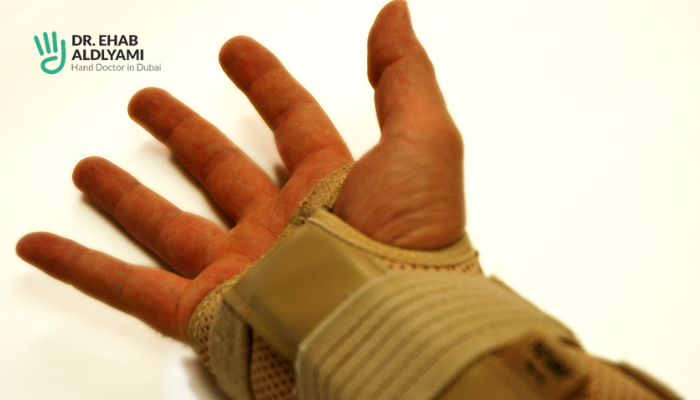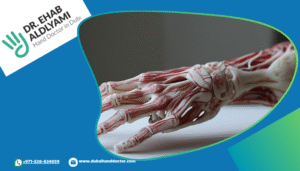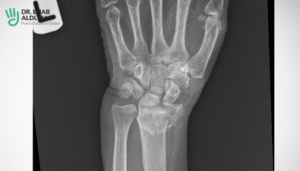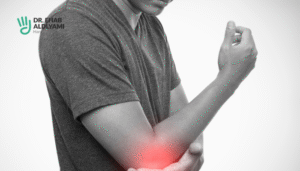How To Tell If Your Hand Is Broken Or Just Sprained
Broken hand vs. sprained hand: How to tell the difference

Ever experienced a sudden jolt to your hand after a fall or an unexpected impact?
That immediate pang of pain, swelling, and difficulty moving can be alarming. Is it just a minor sprain, or is something more serious at play – like a broken hand?
Knowing the difference between a broken hand vs. sprained hand is crucial for proper treatment and a swift recovery.
In Dubai, when you’re looking for expert guidance on hand injuries, Dr. Ehab Bassim Aldlyami stands out as a leading hand specialist. With over two decades of experience, he’s the best orthopedic hand doctor and specialist providing exceptional care for hand injuries and hand-related pain conditions in the UAE.
How to tell if your hand is broken or just sprained - The immediate aftermath
When you’ve injured your hand, the first few moments can be confusing. Both a broken hand and a sprained hand can cause pain and discomfort. However, there are key indicators that can help you understand the severity of your injury.
The human hand is an intricate structure of 27 bones, 27 joints, and more than 100 ligaments and tendons, making it susceptible to various injuries.
Is it a sprain? Understanding a sprained hand
A sprain occurs when the ligaments – the tough, fibrous tissues that connect bones to other bones – are stretched or torn. Think of it as an overextension.
A sprain in the hand can range from mild to severe, and while painful, it generally doesn’t involve a bone fracture.
Common signs of a sprained hand:
- Pain: Often a dull ache, but can be sharp with movement.
- Swelling: Localized around the injured joint or area.
- Tenderness: The area might be sensitive to touch.
- Bruising: May develop over time, but not always immediately or extensively.
- Limited movement: You might experience some difficulty moving the affected fingers or wrist, but usually, some range of motion is still possible.
- Popping sensation: Sometimes, a “pop” or “tear” might be felt at the time of injury, particularly with more severe sprains.
How to tell if your hand is broken or just sprained?
A broken hand, or a hand fracture, means one or more of the bones in your hand have cracked or completely separated. This is a more serious injury and requires immediate medical attention to ensure proper healing and prevent long-term complications.
Key indicators of a broken hand:
- Severe pain: Typically more intense and persistent than a sprain, often worsening with movement or pressure.
- Deformity: The most tell-tale sign. The hand or finger might appear bent, crooked, or out of place.
- Significant swelling: Often immediate and pronounced.
- Intense bruising: Can appear quickly and spread widely.
- Inability to move: You might find it impossible or extremely painful to move the affected part of your hand.
- Numbness or tingling: Nerve damage can occur with a fracture, leading to these sensations.
- Audible snap: You might have heard a distinct “snap” or “crack” at the moment of injury.
- Visible bone (in severe cases): Though rare, in an open fracture, bone might be visible through the skin.
The scaphoid bone, located in the wrist, is one of the most commonly fractured bones in the hand, often due to falls onto an outstretched hand.
Broken hand vs. sprained hand: A side-by-side comparison
To help you quickly differentiate, here’s a summary of the common distinctions between a broken hand vs. sprained hand:
Feature | Sprained Hand | Broken Hand |
Pain | Dull ache, sharp with movement | Severe, persistent, worsens with pressure/movement |
Swelling | Localized, develops gradually | Immediate, often pronounced, widespread |
Deformity | Typically none | Common, visible crookedness or misalignment |
Bruising | May appear, sometimes delayed | Often immediate and extensive |
Movement | Some limited movement is possible | Often impossible or extremely painful |
Sound at Injury | Sometimes a pop or tear | Often, an audible snap or crack |
Numbness/Tingling | Uncommon | Possible |
When to seek medical attention: Don't delay!
Regardless of whether you suspect a broken hand or a sprained hand, it’s always best to err on the side of caution and seek medical evaluation, especially if:
- Severe pain that doesn’t improve with rest and ice
- Any obvious deformity or misalignment in your hand
- You can’t move your fingers or wrist normally
- There’s significant swelling or bruising
- You heard a popping or snapping sound at the time of injury
- Numbness or tingling
How Dr. Ehab Aldlyami can help you
When facing a hand injury in Dubai, Dr. Ehab Bassim Aldlyami is your go-to expert. As an experienced hand specialist in Dubai, he has dedicated his career to providing the best possible care for a wide range of hand and wrist conditions.
Whether you’re dealing with the uncertainty of a broken hand vs. sprained hand, or suffering from chronic hand pain, Dr. Aldlyami offers comprehensive and compassionate treatment.
Regain full function and comfort in your hands; book an appointment!
Related Post

مدة علاج العظم الزورقي: كل ما تحتاج معرفته عن علاج كسر العظم الزورقي
العظم الزورقي هو أحد العظام الصغيرة الموجودة في اليد التي تقع في المعصم. بالرغم من

اعراض وعلاج تمزق اربطة اليد
تمثل اليد أحد أكثر أجزاء الجسم استخدامًا في الحياة اليومية، مما يجعلها عرضة للإصابات

Scaphoid fracture: Causes, symptoms & treatment options
In the world of hand and wrist injuries, few conditions are as deceptively subtle yet

What to Know About a Distal Radius Fracture: Causes, Symptoms & Treatment
The distal radius fracture is the most common broken wrist. It can follow a simple

5 Common Hand Disorders & Their Treatments
Our hands play an essential role in nearly every task we do, from simple daily

Hand Pain Isn’t Always What It Seems: Insight from a Doctor
We use our hands for nearly everything — from sending texts to cooking dinner or




